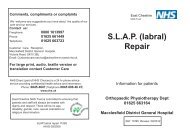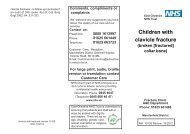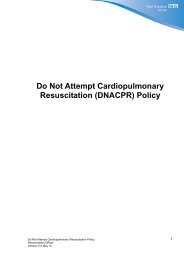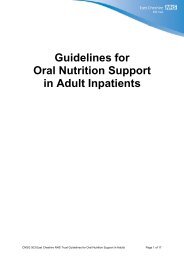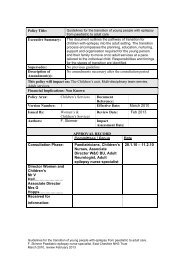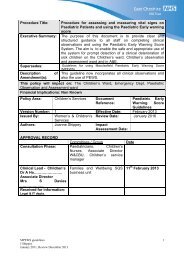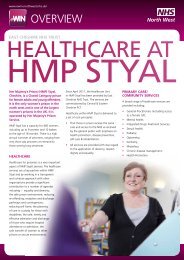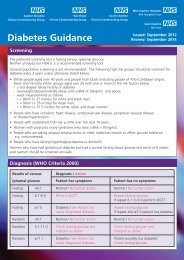Post death procedure - East Cheshire NHS Trust
Post death procedure - East Cheshire NHS Trust
Post death procedure - East Cheshire NHS Trust
You also want an ePaper? Increase the reach of your titles
YUMPU automatically turns print PDFs into web optimized ePapers that Google loves.
If a person has died with a known or suspected infection, it is essential and a legalresponsibility, that all persons who may be involved in handling the body are informed of thepotential risk of infection. They should be told of the risks but not the specific diagnosis asthis remains confidential, even after <strong>death</strong>. The persons who need to know include:a. In Hospital: ward staff, porters, mortuary staff, the bereaved relatives and the funeraldirectors.b. At Home: the nurse laying out, bereaved relatives and the funeral directors.c. Elsewhere: emergency services staff will usually take the same universal precautionsfor handling all bodies.The funeral directors should inform the relatives, in writing, of any risks.It is important that good liaison is maintained between staff on the wards, microbiology andhistopathology laboratories, portering and mortuary departments, the undertaker, the nextof kin and the Consultant Microbiologist. Communication between mortuary staff andfuneral directors is particularly important. Co-ordinating of viewing, hygienic and ritual bodypreparation and then bagging of the deceased in the ward, examination or storage in themortuary and, finally, collection for disposal by the funeral directors and any further hygienicpreparation or embalming that is to be done.4. LAST OFFICESThe most final act of care for a patient is that of laying out. It is necessary to be mindful ofany infection risks and the precautions necessary to protect others. Mortuary staff and/orfuneral directors must be informed if the patient was receiving specific infection controlnursing other than for antibiotic resistant organisms or protective isolation. Use a Biohazardlabel.Nursing staff performing the last offices must follow the same working practices as whenthe patient was alive as stated in the Infection Prevention & Control Good Practices Policy.When preparing the body consideration must be given to control the loss of blood and orbody fluids. Last offices should therefore include: Check identification band is on wrist. Cleaning the body of any soiling and body fluids, including nasal and oral cleansingalso putting in cleaned dentures. Observing the body for wounds and puncture sites and applying waterproof pressuredressings wherever practicable. If the <strong>death</strong> is to be referred to the coroner, newly introduced drains, intravenouslines, catheters, etc. must be left in situ. Tubing must be clamped, spigotted ordrainage bags attached to prevent syphoning. Plugging the mouth and nostrils, if necessary, to prevent discharges, eg. in cases ofsevere abdominal obstruction. Emptying the bladder, if necessary, by applying pressure to the abdomen.25/34





